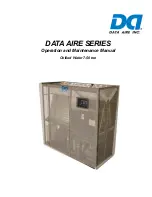
Page 54
Maintenance
ence of bubbles indicates that the dehydrating filter is
clogged or the charge insufficient.
A colour indicator is positioned inside the sight glass.
If you compare the colour of the indicator to the scale
on the ring of the sight glass, you can calculate the
percentage of humidity of the refrigerant. If it is exces-
sive, replace the filter’s cartridge, operate the appli-
ance for 1 day and then check the humidity % again.
When the humidity % is within the pre-determined
range, no other operations are required. If the hu-
midity % is still too high, replace the dehydrating filter
again, start the unit and operate it for another day.
9.9 Electronic expansion valve
The circuit of the unit is equipped with a electronic ex-
pansion valve, with external equalizer
The valve is factory calibrated for an overheating of 5°C.
Procedure to check for overheating:
– Measure the suction pressure with the pressure
gauges on the board of the unit o using a pressure
gauge connected to the service valve on the suction
side.
– From the pressure gauge’s temperature scale,
measure the saturated suction temperature (Tsa)
which corresponds to the pressure value.
– Using a contact pressure gauge affixed to the outlet
fitting of the gas of the evaporator, measure the ac-
tual temperature (Tse).
Overheating calculation (S):
S = Tse - Tsa
Overheating is regulated through the electronic ex-
pansion valve.
Make the adjusting screw follow a complete turn, and
operate the appliance for five minutes.
Check again and, if necessary, repeat the regulation.
If the expansion valve cannot be regulated, it is prob-
ably broken, and shall be replaced. The replacement
must be carried out by a Service Centre.
9.10 Evaporator
Check at regular intervals that the water side of the
heat exchanger is perfectly clean. To do this, measure
the pressure drop, water side (see Section 8) or meas-
ure the temperature of the liquid leaving and entering
the heat exchanger, and compare it to the evaporation
temperature.
To obtain an effective heat exchange, the difference
between the temperature of the leaving water and the
saturated evaporating temperature must be in the 2
- 4°C range. A greater difference would indicate a
low efficiency of the heat exchanger (i.e. the heat ex-
changer is dirty).
In this case, the heat exchanger must be subjected to
chemical cleaning, an operation that shall be carried
out by authorised engineers.
For other maintenance operations (extraordinary
overhauling, replacement of the heat exchanger etc.),
contact an authorised Service Centre.
Summary of Contents for AQVC 105
Page 60: ...English Page 59 Note...
Page 61: ...Page 60 Note...








































